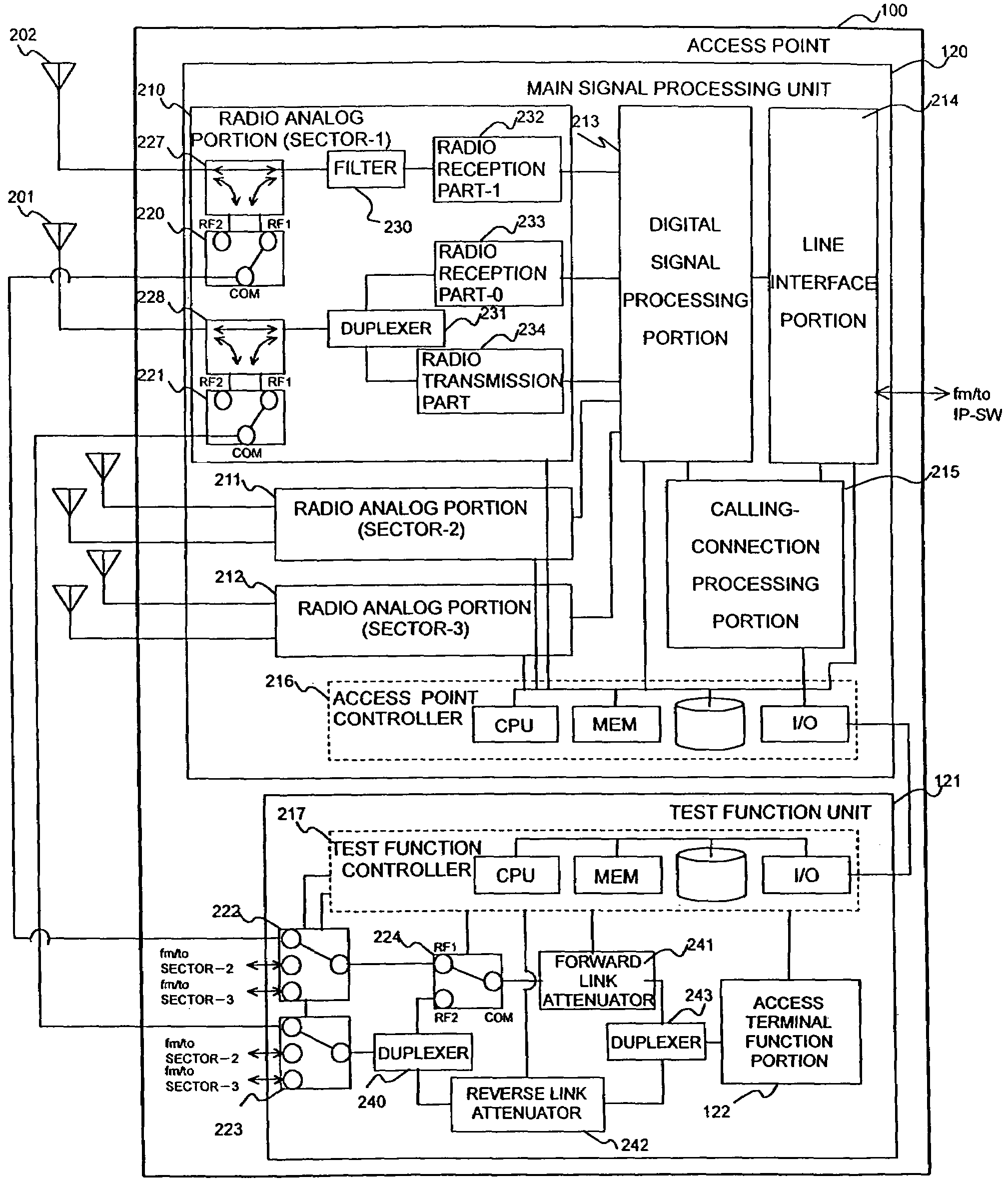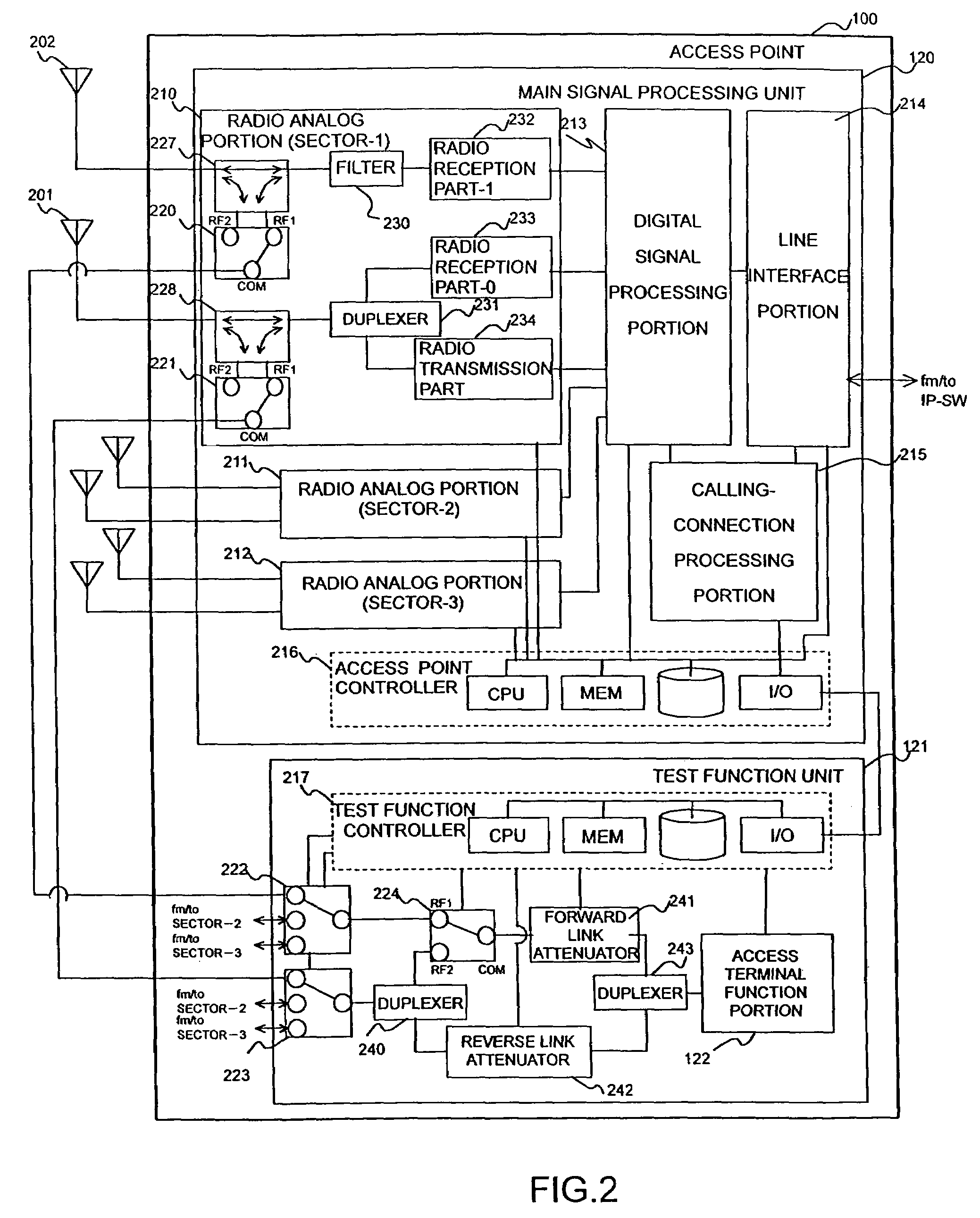Regarding failure detection means for the system, the failure of especially the radio interface portion of the radio access point apparatus is difficult of detection because of the uncertain interface of the very radio channel.
By way of example, in a case where the antenna of the radio access point apparatus has damaged, it is difficult to immediately judge the damage as the failure of the radio access point apparatus, even at the cutoff of the communication with the user access terminal.
On this occasion, such various causes are considered that the particular user will not actually exist in the cell, and that an interference wave will exist in a radio zone connected with the user access terminal, to make the communication impossible.
With the first prior-art example explained above, the antenna failure can be detected, but receiver defects cannot be detected.
Another problem is that, in case of a reception-only antenna or the like, an antenna failure cannot be detected.
However, in a case where a radio reverse link has any abnormality, the maintenance engineer cannot hear the recorded voice.
Also, in a case where a radio forward link has any abnormality, he / she cannot hear the vocal message.
With the second prior-art example explained above, the normality of the access-point radio apparatus can be verified, but an antenna failure cannot be detected.
Another problem is that the verifiable normality is merely the propriety of communication, and that a radio characteristics change, such as the degradation of a reception performance attendant upon a failure of slight degree, cannot be quantitatively decided.
Patent Document 4, however, contains nothing about a normality test for communication and discloses an abnormality detecting method for the receiver.
The bestowal of redundant setups on all the access point apparatuses increases a system constructing cost, and drastically spoils economy.
Nevertheless, when the service is interrupted by any failure, a service quality lowers for users, and also a business company offering the service suffers the drawback of being incapable of accounting, so that the service interruption ascribable to the occurrence of the failure must be avoided to the utmost.
Since, however, the interface between user access terminals and a radio access point is a radio channel in the mobile communication system, a communication quality changes depending upon an environment which surrounds a mobile access point or a fixed access point, and it is very difficult to decide whether an inferior communication quality is ascribable to the apparatus failure or the surrounding environment.
When an interference wave from the radio access point of the other system is inputted, it becomes difficult to detect a reception signal from the mobile access terminal of the pertinent system.
On the other hand, the phenomenon is considered to be ascribable to the failure of the radio access point apparatus.
The first failure example is an antenna failure.
The second failure example is a receiver failure.
By way of example, when one receiver has undergone the failure in an access terminal which implements diversity reception by installing a plurality of receivers, a reception performance degrades.
The third failure example is a transmitter failure.
It is considered that the signal quality of reverse links will have degraded due to the transmitter failure of the access point, and that access terminals will communicate with the neighboring access point of good signal quality, resulting in the decrease of the number of connected access terminals.
In this manner, in the mobile communication system, the same phenomena as in the failure occurrences (for example, the small number of connected access terminals) may highly possibly be observed in spite of the normal operation of the system itself, and various causes are considered for the failures, so that the failure detection is very difficult.
When it is intended to detect the above failure examples by the prior-art failure detection means, problems as stated below are involved.
Accordingly, this technique cannot detect the case of a failure which permits the communication, but which degrades the radio quality, as in the above failure example.
Further, the technique which is contained in Patent Document 4 cited as the third prior-art example cannot detect the first failure example and the third failure example.
Moreover, since only the decision based on the power is rendered, even the receiver failure being the second failure example cannot be detected in the case of, for example, a reception quality degradation ascribable to a phase characteristics degradation.
As thus far explained, it is the actual situation that comprehensive techniques are not available as the failure detection means and testing method for the radio access point apparatus.
Besides, in the mobile communication system, especially in a portable telephone system of CDMA format wherein communication is held by finely controlling the transmission power of each mobile access terminal, the characteristics degradation of the radio access point incurs increase in the transmission power of the mobile access terminal and leads to the lowering of serviceability as shortens a communicable time period.
 Login to View More
Login to View More  Login to View More
Login to View More 


